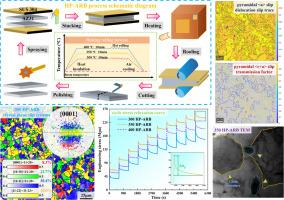当前位置:
X-MOL 学术
›
J. Magnes. Alloys
›
论文详情
Our official English website, www.x-mol.net, welcomes your
feedback! (Note: you will need to create a separate account there.)
Mechanism of work hardening and softening behavior of AZ31 magnesium alloy sheets with hard plate accumulative roll bonding
Journal of Magnesium and Alloys ( IF 15.8 ) Pub Date : 2024-11-09 , DOI: 10.1016/j.jma.2024.10.003 Lu Sun, Feng Li, Jia Yang Zhang, Wen Tao Niu, Mu Zi Cao
Journal of Magnesium and Alloys ( IF 15.8 ) Pub Date : 2024-11-09 , DOI: 10.1016/j.jma.2024.10.003 Lu Sun, Feng Li, Jia Yang Zhang, Wen Tao Niu, Mu Zi Cao

|
In this paper, the work hardening and softening behavior of AZ31 magnesium alloy sheets by hard plate accumulative roll bonding (HP-ARB) process in a specific temperature range was studied for the first time, and the cyclic stress relaxation test, EBSD, TEM and other characterization methods were used. When the rolling temperature is 350 °C, the grain size of magnesium sheets is refined to 4.32 (±0.36) µm on average, and it shows an excellent combination of strength and plasticity. The tensile strength reaches 307 (±8.52) MPa and the elongation is 12.73 (±0.84) %. At this time, the curve of work hardening rate decreases smoothly and the degree of hardening is the lowest, and the amplitude of stress drop Δσp in work softening test is the smallest with the increase of cycle times, which shows that the well coordination between work hardening and softening behavior has been achieved. Research has found that the combined effect of grain boundary strengthening and fine grain strengthening enhances the yield and tensile strength of magnesium sheets after three passes HP-ARB process at 350 °C. This is attributed to the high degree of dislocation slip opening in the pyramidal surface 〈a〉 and 〈c + a〉, which not only coordinates the c-axis strain of the entire grain, but also promotes the slip transfer of dislocations in the fine-grained region, significantly improving the elongation of the sheets. This study provides a new idea for the forming and manufacturing of high performance magnesium alloy sheets.
中文翻译:

AZ31镁合金板硬板累积辊焊的加工硬化和软化行为机理
本文首次研究了硬板累积辊压键合 (HP-ARB) 工艺在特定温度范围内 AZ31 镁合金板的加工硬化和软化行为,并采用了循环应力松弛试验、EBSD、TEM 等表征方法。当轧制温度为 350 °C 时,镁板的晶粒尺寸平均细化到 4.32 (±0.36) μm,表现出强度和塑性的完美结合。拉伸强度达到 307 (±8.52) MPa,伸长率为 12.73 (±0.84) %。此时,加工硬化速率曲线下降平稳,硬化程度最低,随着循环次数的增加,加工软化试验中应力下降Δσp的幅度最小,表明加工硬化与软化行为之间已经实现了良好的协调。研究发现,晶界强化和细晶粒强化的综合作用提高了镁板在 350 °C 下经过 3 次 HP-ARB 工艺后的成品率和抗拉强度。 这归因于金字塔体表面 〈a〉 和 〈c + a〉 高度的位错滑张口,不仅协调了整个晶粒的 c 轴应变,还促进了位错在细粒区域的滑移转移,显著提高了片材的伸长率。本研究为高性能镁合金板的成型和制造提供了新思路。
更新日期:2024-11-09
中文翻译:

AZ31镁合金板硬板累积辊焊的加工硬化和软化行为机理
本文首次研究了硬板累积辊压键合 (HP-ARB) 工艺在特定温度范围内 AZ31 镁合金板的加工硬化和软化行为,并采用了循环应力松弛试验、EBSD、TEM 等表征方法。当轧制温度为 350 °C 时,镁板的晶粒尺寸平均细化到 4.32 (±0.36) μm,表现出强度和塑性的完美结合。拉伸强度达到 307 (±8.52) MPa,伸长率为 12.73 (±0.84) %。此时,加工硬化速率曲线下降平稳,硬化程度最低,随着循环次数的增加,加工软化试验中应力下降Δσp的幅度最小,表明加工硬化与软化行为之间已经实现了良好的协调。研究发现,晶界强化和细晶粒强化的综合作用提高了镁板在 350 °C 下经过 3 次 HP-ARB 工艺后的成品率和抗拉强度。 这归因于金字塔体表面 〈a〉 和 〈c + a〉 高度的位错滑张口,不仅协调了整个晶粒的 c 轴应变,还促进了位错在细粒区域的滑移转移,显著提高了片材的伸长率。本研究为高性能镁合金板的成型和制造提供了新思路。


















































 京公网安备 11010802027423号
京公网安备 11010802027423号